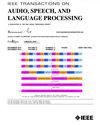Dominance Based Integration of Spatial and Spectral Features for Speech Enhancement
IEEE Transactions on Audio Speech and Language Processing
Pub Date : 2013-12-01
DOI:10.1109/TASL.2013.2277937
引用次数: 36
Abstract
This paper proposes a versatile technique for integrating two conventional speech enhancement approaches, a spatial clustering approach (SCA) and a factorial model approach (FMA), which are based on two different features of signals, namely spatial and spectral features, respectively. When used separately the conventional approaches simply identify time frequency (TF) bins that are dominated by interference for speech enhancement. Integration of the two approaches makes identification more reliable, and allows us to estimate speech spectra more accurately even in highly nonstationary interference environments. This paper also proposes extensions of the FMA for further elaboration of the proposed technique, including one that uses spectral models based on mel-frequency cepstral coefficients and another to cope with mismatches, such as channel mismatches, between captured signals and the spectral models. Experiments using simulated and real recordings show that the proposed technique can effectively improve audible speech quality and the automatic speech recognition score.基于优势度的语音增强空间与频谱特征集成
本文提出了一种集成两种传统语音增强方法的通用技术,即空间聚类方法(SCA)和因子模型方法(FMA),这两种方法分别基于信号的两个不同特征,即空间特征和频谱特征。当单独使用时,传统方法简单地识别受干扰主导的时间频率(TF)箱以增强语音。两种方法的集成使得识别更加可靠,并且允许我们在高度非平稳干扰环境中更准确地估计语音频谱。本文还提出了FMA的扩展,以进一步阐述所提出的技术,包括使用基于梅尔频率倒谱系数的频谱模型,以及处理捕获信号与频谱模型之间的不匹配,例如信道不匹配。仿真和真实录音实验表明,该方法能有效提高可听语音质量,提高语音自动识别分数。
本文章由计算机程序翻译,如有差异,请以英文原文为准。
求助全文
约1分钟内获得全文
求助全文
来源期刊
自引率
0.00%
发文量
0
审稿时长
24.0 months
期刊介绍:
The IEEE Transactions on Audio, Speech and Language Processing covers the sciences, technologies and applications relating to the analysis, coding, enhancement, recognition and synthesis of audio, music, speech and language. In particular, audio processing also covers auditory modeling, acoustic modeling and source separation. Speech processing also covers speech production and perception, adaptation, lexical modeling and speaker recognition. Language processing also covers spoken language understanding, translation, summarization, mining, general language modeling, as well as spoken dialog systems.

 求助内容:
求助内容: 应助结果提醒方式:
应助结果提醒方式:


